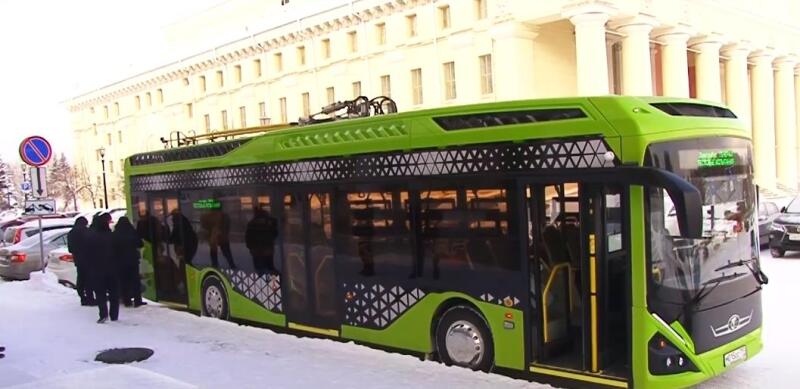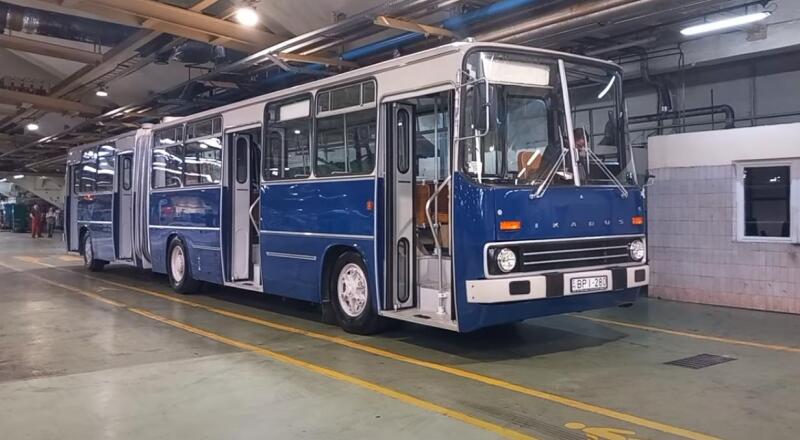And now it’s the turn of the new model – “General”, which received the index 62181. The company’s development became known back in mid-2022. However, the general public was able to get acquainted with the new product in more detail at the 11th ElectroTrans exhibition, held in the capital in September of the same year.
What's special about the new model
In terms of technical aspects, it is a universal method for replenishing battery capacity. The electric bus can be recharged using one of three methods. The first is the slowest (2 hours), from an outlet, the second, called dynamic, is through pantographs from the contact network of trolleybuses or trams. And the fastest replenishment of capacity (45 minutes) is carried out from charging stations with a voltage of 380 or 600 volts.
 Electric bus being tested. Photo: YouTube.com
Electric bus being tested. Photo: YouTube.comIn autonomous mode, the car is capable of covering from 30 to 200 km. The exact figure is related to the characteristics of the batteries, the capacity of which, depending on customer requirements, is 93-217 kWh.
Why is such charge versatility needed?
The design developers carefully studied the situation with public transport in Russia and other countries of the world. The conclusion was clear: everywhere you need a machine capable of “fully using” the existing infrastructure. This will allow a minimal increase in the number of drivers, who are already in short supply, plus operating costs will be reduced.
 Driver's workplace. Photo: YouTube.com
Driver's workplace. Photo: YouTube.comWhy didn’t ordinary electric buses satisfy the engineers of PC TS LLC and they created a car with a universal charging method? After all, such a design will probably be more expensive. However, for example, the capital's electric buses require regular replenishment of energy along the route, and this wastes precious time. As a result, it is necessary to increase the number of cars on the line and, consequently, the number of drivers. Electric buses with night charging do not solve the problem, because additional batteries are installed in them, which reduces passenger capacity.
 The spacious salon has hanging chairs. Photo: YouTube.com
The spacious salon has hanging chairs. Photo: YouTube.com“General” is a different matter, largely devoid of such shortcomings. An electric bus (although this name does not fully reflect the essence of this vehicle) can easily use both the trolleybus contact network and the tram network, plus fast recharging from stationary posts. The hybrid method of energy replenishment made it possible to maintain a relatively large power reserve without increasing the battery capacity. For example, during testing in Cherepovets, the vehicle was recharged at the final station along the route, which ensured its operation throughout the entire work shift.
Batteries and electric motors
Two companies supply traction motors: Ruselprom from Vladimir and a mechanical plant from Pskov. The power unit was placed in the rear of the body on the left side. From the electric motor, torque is transmitted via a cardan shaft to a portal axle manufactured by Weichai (China). However, in the future it is planned to replace the unit with a Russian one from Rostar (Naberezhnye Chelny). This company already supplies parts and components of the front suspension for the General. Today it is independent, but it is also possible to establish the opposite version of the design. Pantographs (trolleybus “horns”) and electric heaters are produced by Belrobot and other Russian companies.
 There are ports for charging gadgets. Photo: YouTube.com
There are ports for charging gadgets. Photo: YouTube.comLithium-ion batteries - from SAE: Autonomous Energy Systems company, located in St. Petersburg. From two to eight battery packs are placed on the roof of the electric bus. In theory, a car with the air conditioner turned off, without a working heater and with a battery of maximum capacity will travel 200 km in autonomous mode. But in reality, the power reserve is around 100 km.










